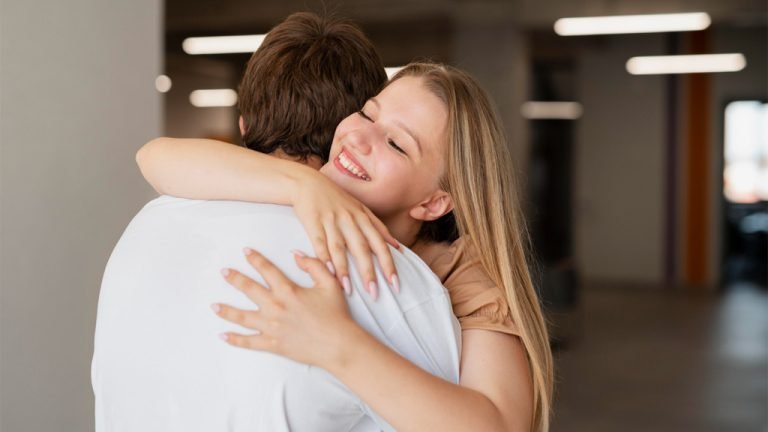I want to give my followers a hugging therapy
So come to me for all your problems in god we trust ,lets spread love love and love
A young dragon learns to control emotions with help from a warm, loving family. . . . Signaled by a massive scowl and wisps of red emanating from the beast’s nose, frustration mounts. The red grows, taking over arms and legs, until the whole tot is engulfed in a fiery red hue. The accompanying text explodes in bigger and bolder lettering across the page. ‘Whenever I get angry, I flame! Then something gets burned.’ Crayon-textured fire spews from the youngster’s mouth. Each person in the dragon’s family loses something to the blazing anger: Mommy’s flowers, Daddy’s chair, and Brother’s toys are all charred. A textured, all-black spread reveals that even the dragon feels burned. ‘It makes me feel so terrible and lonely and guilty.’ But there is a quick fix. The little dragon just needs a hug. The whole family puts their arms around each other and squeezes. . . . Authentically and sympathetically acknowledges the often mystifying nature of anger.” — Kirkus
Oxytocin is a chemical in our bodies that scientists sometimes call the “cuddle hormone.” This is because its levels rise when we hug, touch, or sit close to someone else. Oxytocin is associated with happiness and less stress. Scientists have found that this hormone has a strong effect in women.
Hugging behavior has been studied in the light of anthropology, anchored in communication theory, which includes many facets, e.g., facial expressions such as looking and smiling, kinesics, i.e., all discriminable bodily movements81) described body contact as, “… consists of a total embrace, bringing both arms around the friend’s body, with frontal trunk contact and head contact. There is much hugging, squeezing, patting, cheek-pressing, and kissing. This may be followed by intense eye-contact at close range, cheek-clasping, mouth-kissing, hair-stroking, laughing, even weeping, and, of course, continued smiling.” Hugging occurs in such situations and is expressed in many social contexts, for example, when saying good-bye after parties, or as a gesture of empathy or comfort.
In the Western world, introductory greeting behavior often starts with handshaking and continues with presenting the name of the promoter of the greeting .Greeting behavior varies from a nod to a colleague or acquaintances to a closer salutation consisting of a handshake with a hug (defined as enclosing and pressing each other’s bodies and sometimes kissing), most often reserved for intimate friends and loved ones. These behaviors may occur in both greeting and parting situations.
But teaching anything these days comes with ‘conditions-apply’ tag. In an attempt to make children open up to ‘touch’, a parent should be careful not to cross boundaries. Forcing a child to hug or display affection is the last thing you would want to do. In an attempt to make our children more receptive to affection, do not force them into hugging that uncle they are not fond of or that aunt who squeezes them tight. Let them choose. The consent should lie with them.
As a rule, hugging may refer to physical sensations, a psychological sense of well-being, and often a positive emotional experience. In particular, the positive emotional experience gives rise to biochemical and physiological reactions, such as a higher magnitude of plasma oxytocin, norepinephrine, cortisol, and changes in blood pressure. In the last few years, researchers have commented that in addition to hugging, bodily touches of other kinds, such as hand-holding, also give rise to both positive psychological and physiological changes. The duration of the hug, the style of body touching, the pressure of the body, and the activity of arms and hands disclose the intensity of relationship. The more frequent these behaviors, the closer the relationship. The way one returns a hug can vary greatly, dependent upon the emotional state of the other person. In other words, the hug may be more “state-” than “trait-dependent.” However, the extraverted personality facilitates taking the initiative in hugging, as extraversion is associated with spontaneity, impulsiveness, warmth, and sociability. Anxiety, lack of self-esteem, and lack of self-confidence, which are evident in neuroticism, may decrease the likelihood of taking the initiative to hug.
The prevalence of hugging, particularly among young people, has been reported from time to time in the mass media and might have gained ground, although there is no conclusive empirical evidence for this. A change from less nodding and handshaking to more hugging and embracing in a friendly encounter may originate from a need for closeness and affection, since hugs are a manifestation of concern and support of an individual. A hug has great positive significance most of the time, although in some situations may be considered more of a social requirement, than a natural and free behavior. Such aspects must be included in any observational study of hugging behavior.
Further research is needed to study physical sensitivity and reactions during the hugging and the most frequent emotions and thoughts during this short space of time. The ability to “read” or understand the message of a hug may depend on many factors and ought to be a natural topic of the nonverbal communication research. If the effects of hugging prove to be beneficial to both individuals and society, encouragement in an educational context might become a vital part of public wellness programs.






